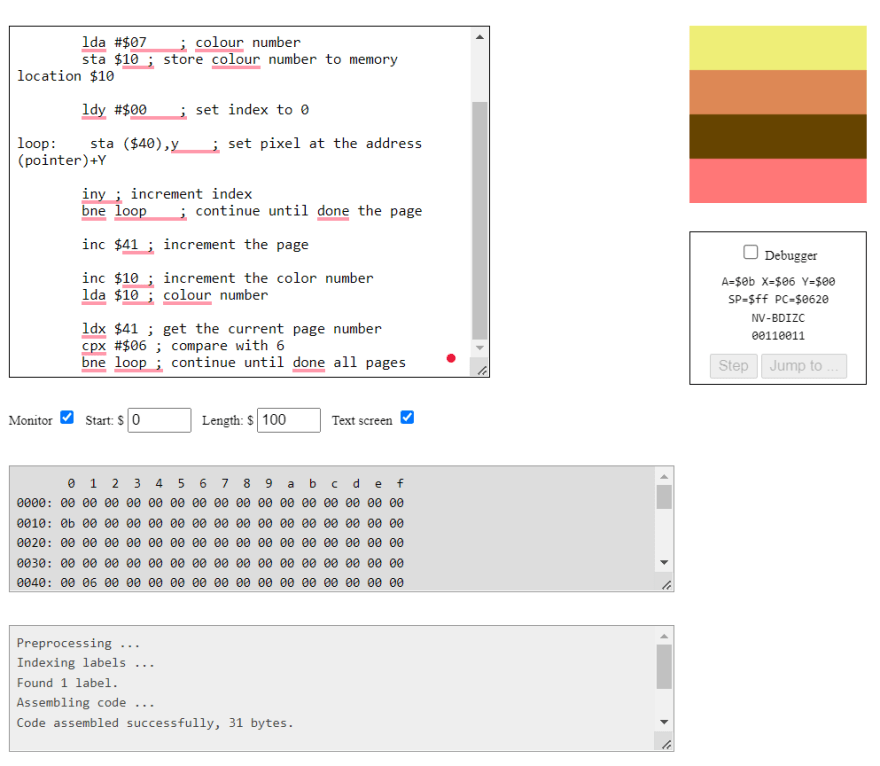SPO600 Lab 2: Working with 6502 Emulator and bitmapped display.

Smit Gabani
Posted on September 17, 2022
In this post, I'm going to do some exercises using 6502 Emulator
I have already filled the bitmap display with yellow color. In this post, I'm going to change the code to get some different results.
The source code will will work on:
lda #$00 ; set a pointer in memory location $40 to point to $0200
sta $40 ; ... low byte ($00) goes in address $40
lda #$02
sta $41 ; ... high byte ($02) goes into address $41
lda #$07 ; colour number
ldy #$00 ; set index to 0
loop: sta ($40),y ; set pixel colour at the address (pointer)+Y
iny ; increment index
bne loop ; continue until done the page (256 pixels)
inc $41 ; increment the page
ldx $41 ; get the current page number
cpx #$06 ; compare with 6
bne loop ; continue until done all pages
The result the code generates.

Assemble > Run > No errors > Yellow output.
Now lets modify the code to make the following changes.
- Change the code to fill the display with light blue instead of yellow. (Tip: you can find the colour codes on the 6502 Emulator page).
- Change the code to fill the display with a different colour on each page (each "page" will be one-quarter of the bitmapped display).
Making the changes.
Changing the color from yellow to light blue.
To chage the color from yellow to light blue we can change the line
lda #$07 to lda #$e
The color numbers are:
$0: Black
$1: White
$2: Red
$3: Cyan
$4: Purple
$5: Green
$6: Blue
$7: Yellow
$8: Orange
$9: Brown
$a: Light red
$b: Dark grey
$c: Grey
$d: Light green
$e: Light blue
$f: Light grey
The desired result is obtained.
I have checked the monitor checkbox to see how the light blue color is stored.
Change the code to fill the display with a different colour on each page.
Now, I'm going to change the code to fill the display with a different color on each page (each page: one-quarter of the bitmapped display).
This line is responsible for generating random color. (not exactly random).
inc $10 ; increment the color number
This is the final code:
lda #$00 ; set a pointer at $40 to point to $0200
sta $40
lda #$02
sta $41
lda #$07 ; colour number
sta $10 ; store colour number to memory location $10
ldy #$00 ; set index to 0
loop: sta ($40),y ; set pixel at the address (pointer)+Y
iny ; increment index
bne loop ; continue until done the page
inc $41 ; increment the page
inc $10 ; increment the color number
lda $10 ; colour number
ldx $41 ; get the current page number
cpx #$06 ; compare with 6
bne loop ; continue until done all pages
The final result:
This code will generate rendom color page using random color number ($fe)
You can also set the first color as a random color (lda $fe) by using pseudo-random number generator (PRNG) at $fe
lda #$00 ; set a pointer at $40 to point to $0200
sta $40
lda #$02
sta $41
lda $fe ; random color
sta $10 ; store colour number to memory location $10
ldy #$00 ; set index to 0
loop: sta ($40),y ; set pixel at the address (pointer)+Y
iny ; increment index
bne loop ; continue until done the page
inc $41 ; increment the page
inc $10 ; increment the color number
lda $10 ; colour number
ldx $41 ; get the current page number
cpx #$06 ; compare with 6
bne loop ; continue until done all pages
The more I work with the emulator the more I understand it.

Posted on September 17, 2022
Join Our Newsletter. No Spam, Only the good stuff.
Sign up to receive the latest update from our blog.








